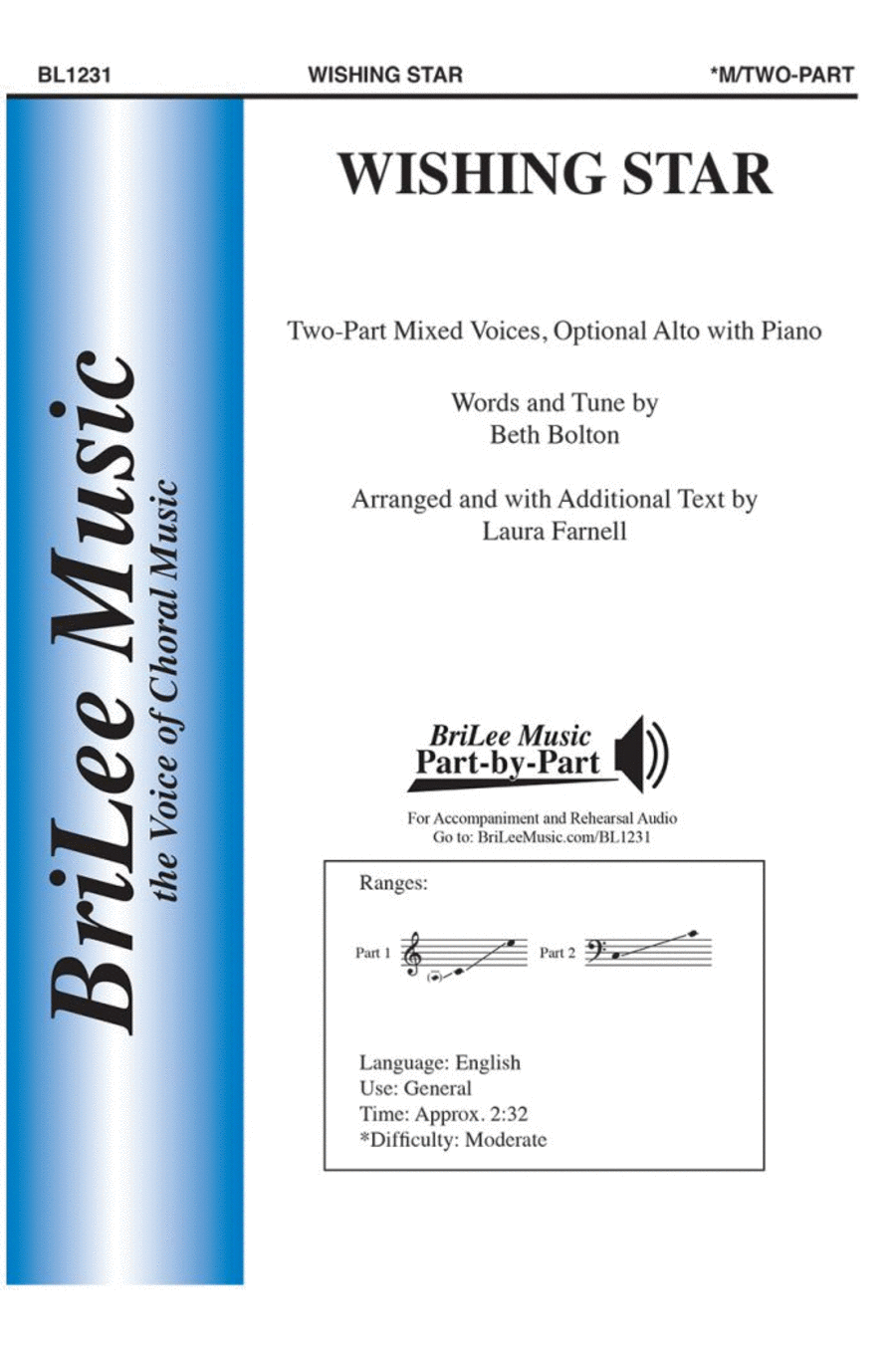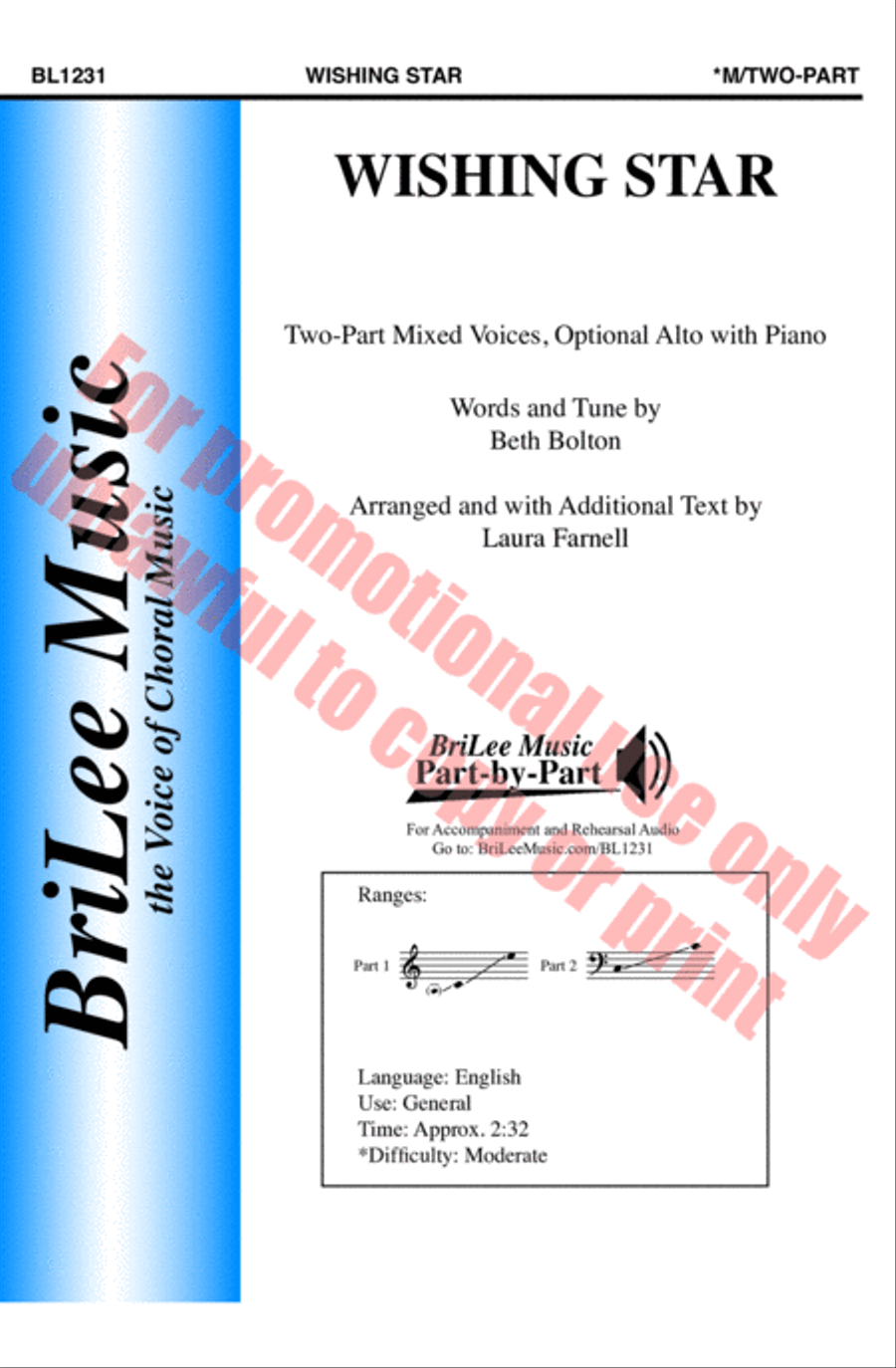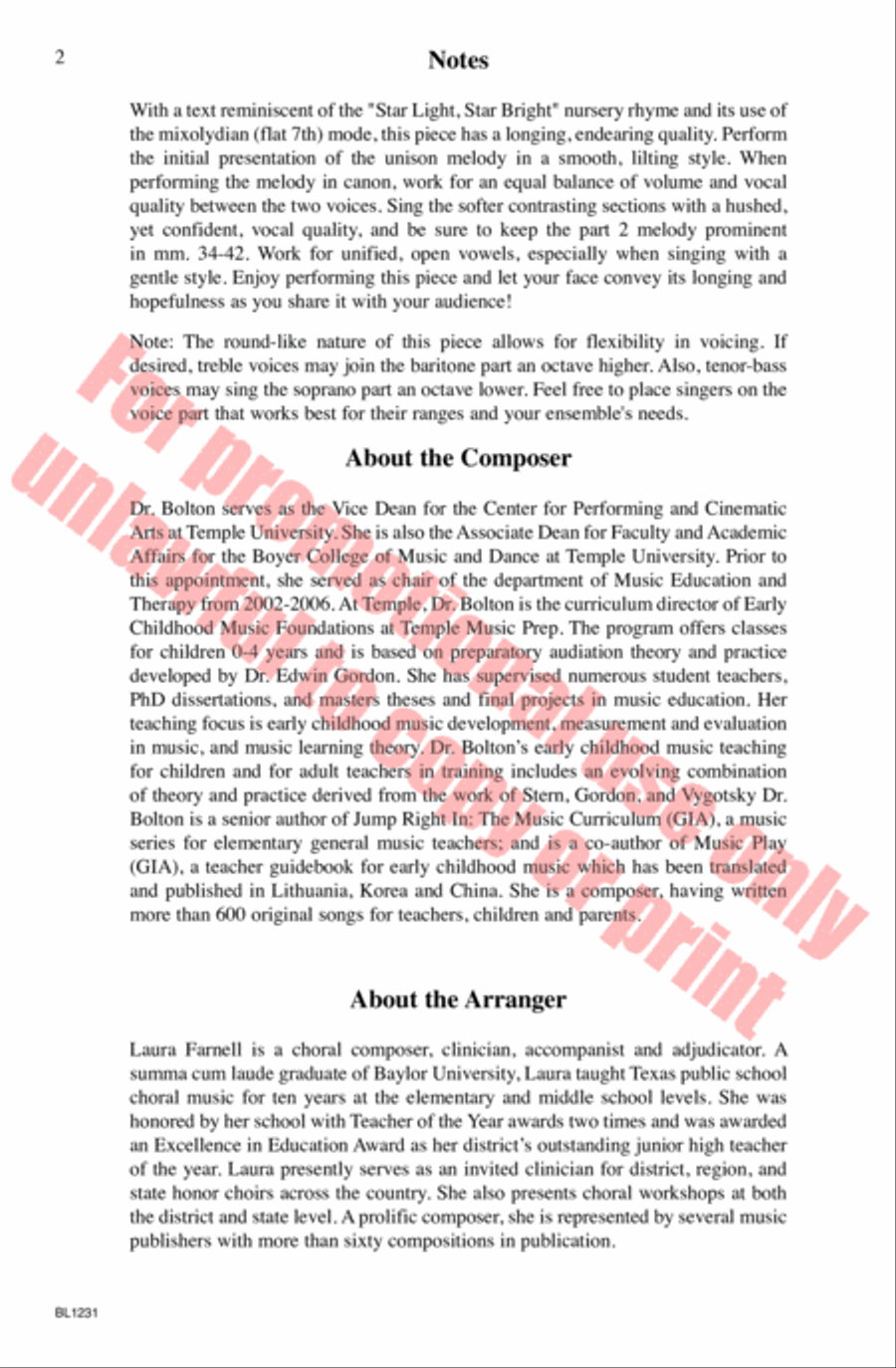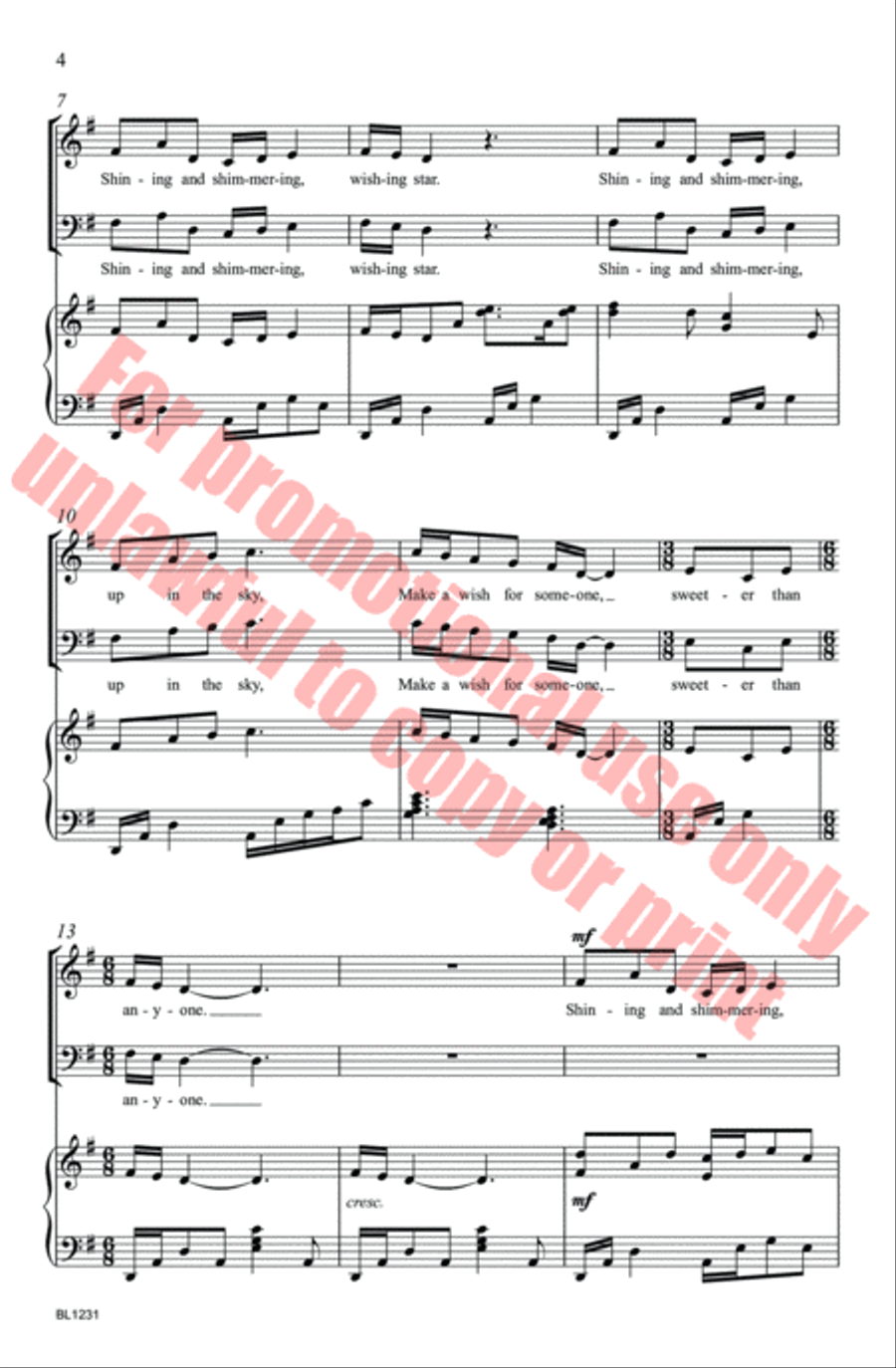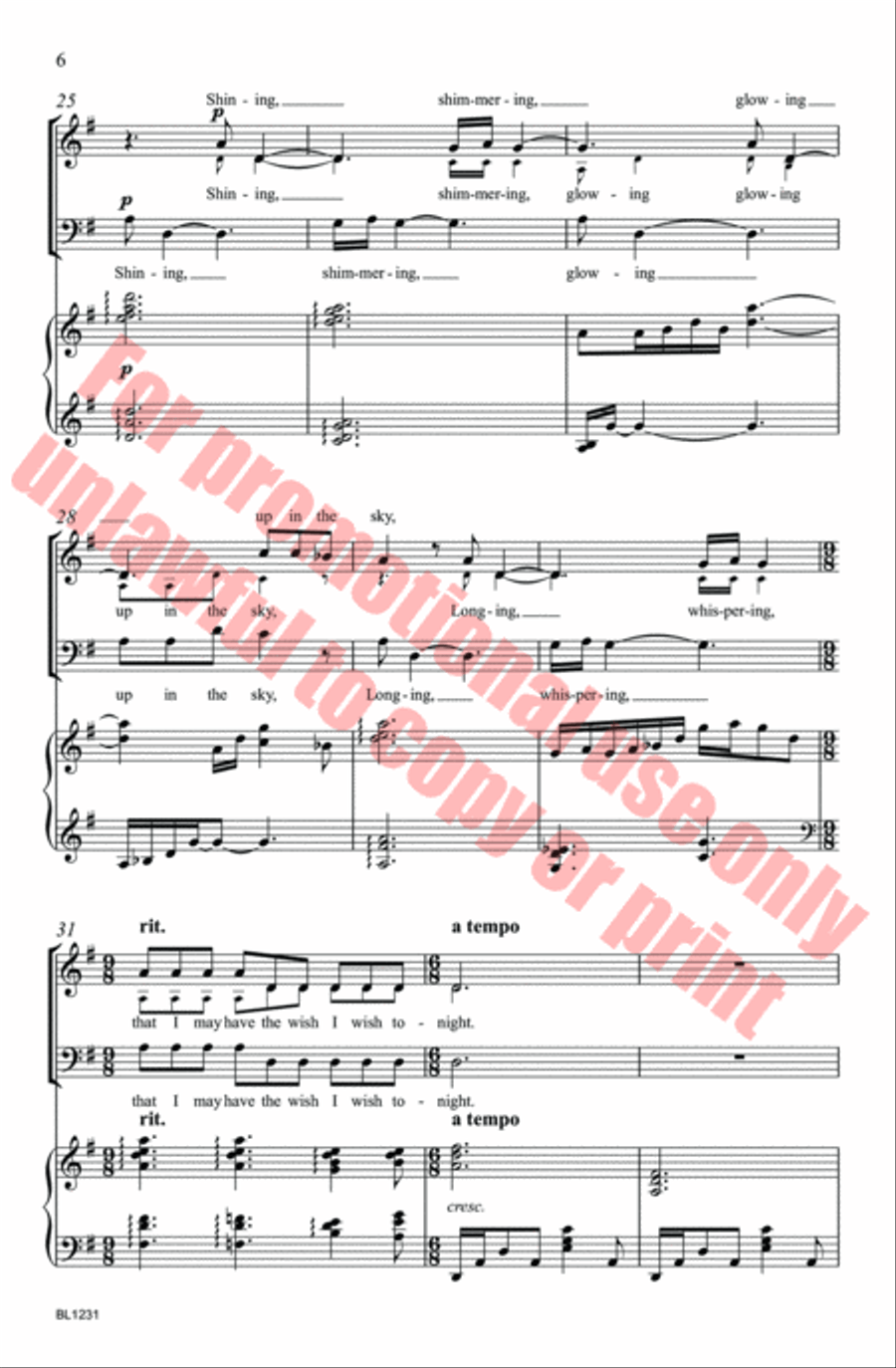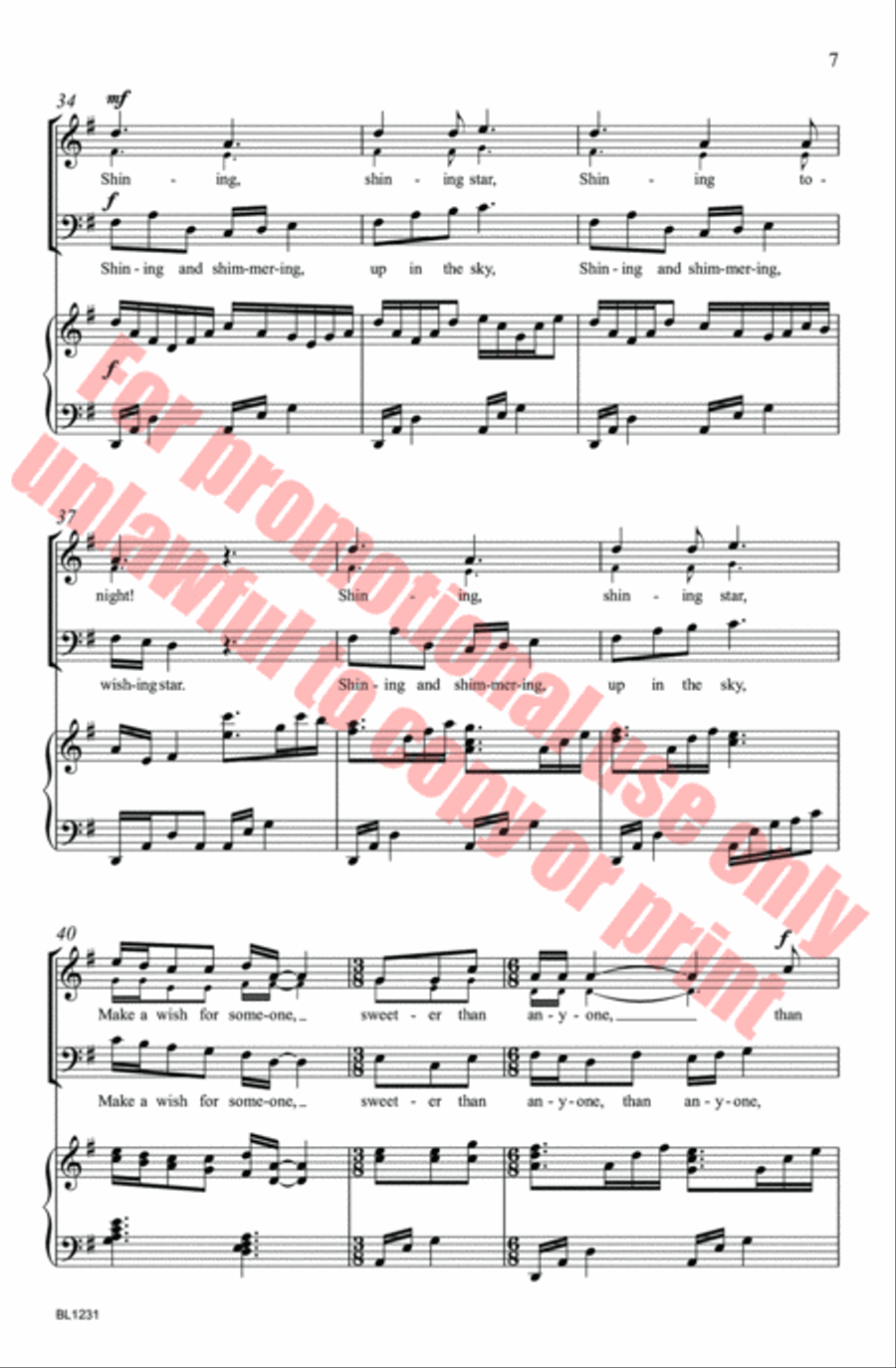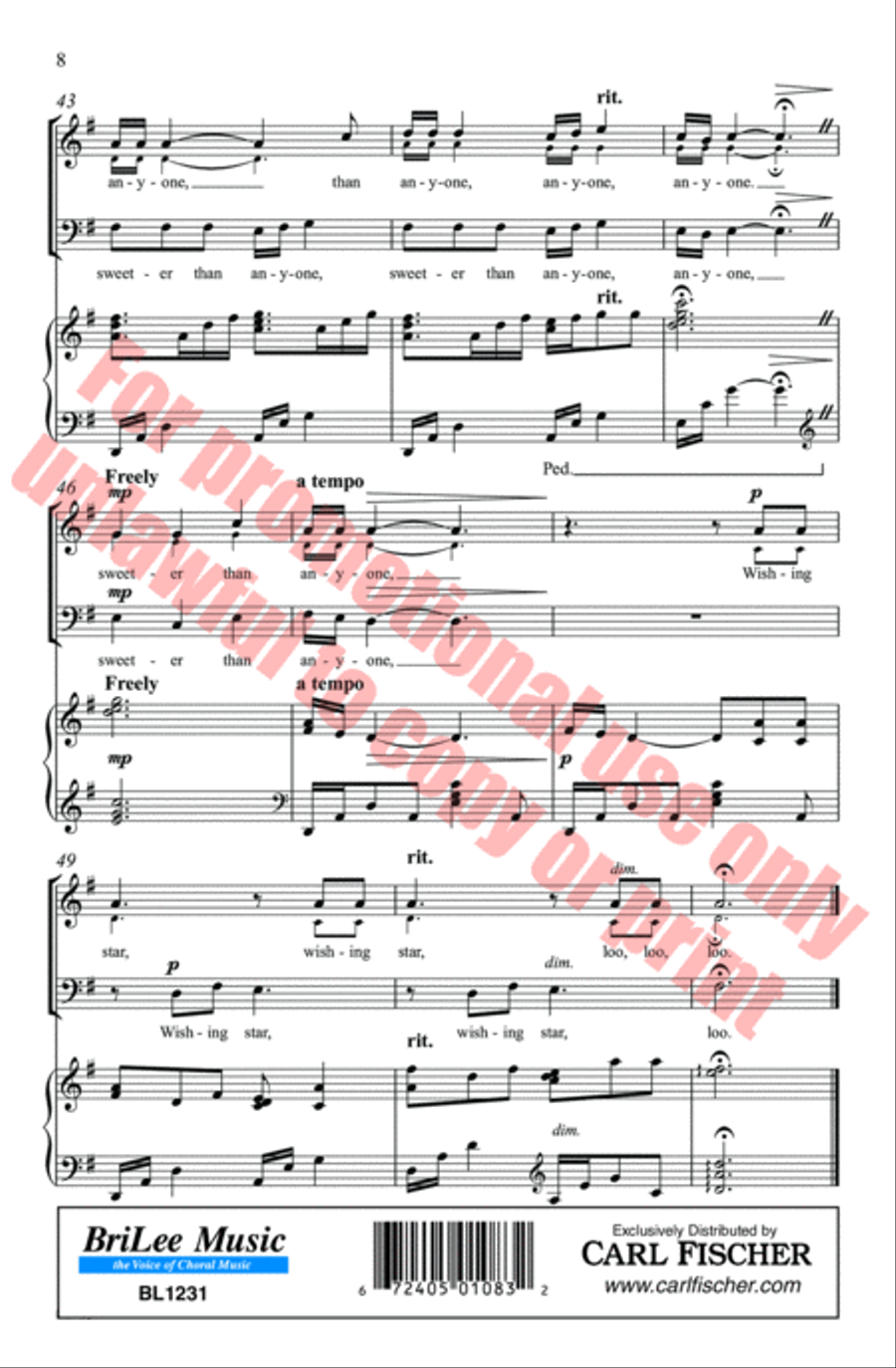Choral 3-pt chorus, piano
SKU: CF.BL1231
Composed by Laura Farnell. Octavo. 8 pages. Duration 0:02:32. BriLee Music #BL1231. Published by BriLee Music (CF.BL1231).
UPC: 672405010832. 6.875 x 10.5 inches. Key: D mixolydian. English.
With a text reminiscent of the "Star Light, Star Bright" nursery rhyme and its use of the mixolydian (flat 7th) mode, this piece has a longing, endearing quality. Perform the initial presentation of the unison melody in a smooth, lilting style. When performing the melody in canon, work for an equal balance of volume and vocal quality between the two voices. Sing the softer contrasting sections with a hushed, yet confident, vocal quality, and be sure to keep the part 2 melody prominent in mm. 34-42. Work for unified, open vowels, especially when singing with a gentle style. Enjoy performing this piece and let your face convey its longing and hopefulness as you share it with your audience! Note: The round-like nature of this piece allows for flexibility in voicing. If desired, treble voices may join the baritone part an octave higher. Also, tenor-bass voices may sing the soprano part an octave lower. Feel free to place singers on the voice part that works best for their ranges and your ensemble's needs. Dr. Bolton serves as the Vice Dean for the Center for Performing and Cinematic Arts at Temple University. She is also the Associate Dean for Faculty and Academic Affairs for the Boyer College of Music and Dance at Temple University. Prior to this appointment, she served as chair of the department of Music Education and Therapy from 2002-2006. At Temple, Dr. Bolton is the curriculum director of Early Childhood Music Foundations at Temple Music Prep. The program offers classes for children 0-4 years and is based on preparatory audiation theory and practice developed by Dr. Edwin Gordon. She has supervised numerous student teachers, PhD dissertations, and masters theses and final projects in music education. Her teaching focus is early childhood music development, measurement and evaluation in music, and music learning theory. Dr. Bolton's early childhood music teaching for children and for adult teachers in training includes an evolving combination of theory and practice derived from the work of Stern, Gordon, and Vygotsky Dr. Bolton is a senior author of Jump Right In: The Music Curriculum (GIA), a music series for elementary general music teachers; and is a co-author of Music Play (GIA), a teacher guidebook for early childhood music which has been translated and published in Lithuania, Korea and China. She is a composer, having written more than 600 original songs for teachers, children and parents. Laura Farnell is a choral composer, clinician, accompanist, and adjudicator from Arlington, Texas. After graduating summa cum laude from Baylor University with her Bachelor of Music Education in Choral Music (with a piano emphasis), Laura taught elementary music for two years in Mansfield, Texas, followed by eight years of teaching junior high choir in Arlington, Texas. She was honored by both of her schools with Teacher of the Year awards in 2000 and 2003, and she received an Excellence in Education Award in 2004 as the Arlington Independent School District's outstanding junior high teacher of the year. Laura presently serves as an invited clinician for district, region, and state honor choirs across the country. She also presents workshops and music reading sessions for choir directors at both district and state levels. She has served as a clinician and/or presented at music conferences in Arkansas, Colorado, Florida, Illinois, Iowa, Kansas, Mississippi, Missouri, North Carolina, Oklahoma, Texas, and Wisconsin. A prolific composer, she especially enjoys writing and arranging music for middle school choirs. She is represented by several music publishers with more than sixty choral compositions in print. She is the co-author of the SOS Sight-singin.
With a text reminiscent of the "Star Light, Star Bright" nursery rhyme and its use of the mixolydian (flat 7th) mode, this piece has a longing, endearing quality. Perform the initial presentation of the unison melody in a smooth, lilting style. When performing the melody in canon, work for an equal balance of volume and vocal quality between the two voices. Sing the softer contrasting sections with a hushed, yet confident, vocal quality, and be sure to keep the part 2 melody prominent in mm. 34-42. Work for unified, open vowels, especially when singing with a gentle style. Enjoy performing this piece and let your face convey its longing and hopefulness as you share it with your audience!Note: The round-like nature of this piece allows for flexibility in voicing. If desired, treble voices may join the baritone part an octave higher. Also, tenor-bass voices may sing the soprano part an octave lower. Feel free to place singers on the voice part that works best for their ranges and your ensemble's needs.Dr. Bolton serves as the Vice Dean for the Center for Performing and Cinematic Arts at Temple University. She is also the Associate Dean for Faculty and Academic Affairs for the Boyer College of Music and Dance at Temple University. Prior to this appointment, she served as chair of the department of Music Education and Therapy from 2002-2006. At Temple, Dr. Bolton is the curriculum director of Early Childhood Music Foundations at Temple Music Prep. The program offers classes for children 0-4 years and is based on preparatory audiation theory and practice developed by Dr. Edwin Gordon. She has supervised numerous student teachers, PhD dissertations, and masters theses and final projects in music education. Her teaching focus is early childhood music development, measurement and evaluation in music, and music learning theory. Dr. Bolton’s early childhood music teaching for children and for adult teachers in training includes an evolving combination of theory and practice derived from the work of Stern, Gordon, and Vygotsky Dr. Bolton is a senior author of Jump Right In: The Music Curriculum (GIA), a music series for elementary general music teachers; and is a co-author of Music Play (GIA), a teacher guidebook for early childhood music which has been translated and published in Lithuania, Korea and China. She is a composer, having written more than 600 original songs for teachers, children and parents.Laura Farnell is a choral composer, clinician, accompanist, and adjudicator from Arlington, Texas. After graduating summa cum laude from Baylor University with her Bachelor of Music Education in Choral Music (with a piano emphasis), Laura taught elementary music for two years in Mansfield, Texas, followed by eight years of teaching junior high choir in Arlington, Texas. She was honored by both of her schools with Teacher of the Year awards in 2000 and 2003, and she received an Excellence in Education Award in 2004 as the Arlington Independent School District’s outstanding junior high teacher of the year. Laura presently serves as an invited clinician for district, region, and state honor choirs across the country. She also presents workshops and music reading sessions for choir directors at both district and state levels. She has served as a clinician and/or presented at music conferences in Arkansas, Colorado, Florida, Illinois, Iowa, Kansas, Mississippi, Missouri, North Carolina, Oklahoma, Texas, and Wisconsin. A prolific composer, she especially enjoys writing and arranging music for middle school choirs. She is represented by several music publishers with more than sixty choral compositions in print. She is the co-author of the SOS Sight-singin.
With a text reminiscent of the "Star Light, Star Bright" nursery rhyme and its use of the mixolydian (flat 7th) mode, this piece has a longing, endearing quality. Perform the initial presentation of the unison melody in a smooth, lilting style. When performing the melody in canon, work for an equal balance of volume and vocal quality between the two voices. Sing the softer contrasting sections with a hushed, yet confident, vocal quality, and be sure to keep the part 2 melody prominent in mm. 34-42. Work for unified, open vowels, especially when singing with a gentle style. Enjoy performing this piece and let your face convey its longing and hopefulness as you share it with your audience!Note: The round-like nature of this piece allows for flexibility in voicing. If desired, treble voices may join the baritone part an octave higher. Also, tenor-bassxa0 voices may sing the soprano part an octave lower. Feel free to place singers on the voice part that works best for their ranges and your ensemble's needs.Dr. Bolton serves as the Vice Dean for the Center for Performing and Cinematic Arts at Temple University. She is also the Associate Dean for Faculty and Academic Affairs for the Boyer College of Music and Dance at Temple University. Prior to this appointment, she served as chair of the department of Music Education and Therapy from 2002-2006. At Temple, Dr. Bolton is the curriculum director of Early Childhood Music Foundations at Temple Music Prep. The program offers classes for children 0-4 years and is based on preparatory audiation theory and practice developed by Dr. Edwin Gordon. She has supervised numerous student teachers, PhD dissertations, and masters theses and final projects in music education. Her teaching focus is early childhood music development, measurement and evaluation in music, and music learning theory. Dr. Bolton’s early childhood music teaching for children and for adult teachers in training includes an evolving combination of theory and practice derived from the work of Stern, Gordon, and Vygotsky Dr. Bolton is a senior author of Jump Right In: The Music Curriculum (GIA), a music series for elementary general music teachers; and is a co-author of Music Play (GIA), a teacher guidebook for early childhood music which has been translated and published in Lithuania, Korea and China. She is a composer, having written more than 600 original songs for teachers, children and parents.Laura Farnell is a choral composer, clinician, accompanist, and adjudicator from Arlington, Texas. After graduating summa cum laude from Baylor University with her Bachelor of Music Education in Choral Music (with a piano emphasis), Laura taught elementary music for two years in Mansfield, Texas, followed by eight years of teaching junior high choir in Arlington, Texas. She was honored by both of her schools with Teacher of the Year awards in 2000 and 2003, and she received an Excellence in Education Award in 2004 as the Arlington Independent School District’s outstanding junior high teacher of the year. Laura presently serves as an invited clinician for district, region, and state honor choirs across the country. She also presents workshops and music reading sessions for choir directors at both district and state levels. She has served as a clinician and/or presented at music conferences in Arkansas, Colorado, Florida, Illinois, Iowa, Kansas, Mississippi, Missouri, North Carolina, Oklahoma, Texas, and Wisconsin. A prolific composer, she especially enjoys writing and arranging music for middle school choirs. She is represented by several music publishers with more than sixty choral compositions in print. She is the co-author of the SOS Sight-singin.
